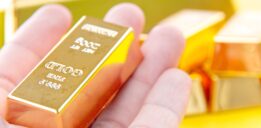BitGold Forecast for 2017: A Completely Unique Gold Investment Opportunity
BitGold arrived with much fanfare back in 2015. The hype surrounding BitGold centered on its unique electronic gold savings and payments platform, which revolutionized the way gold is used. Our BitGold forecast for 2017 seeks to break down whether the hype surrounding the platform is equally warranted for your portfolio. I’ll attempt to answer the most poignant endgame questions: Should you invest in BitGold? What are BitGold price predictions 2017?
Before we get into the BitGold forecast for 2017, it’s important to note that BitGold is now officially known as GoldMoney Inc (TSX:XAU). As a standalone entity, BitGold had previously acquired the world-renowned gold custodian, GoldMoney, for 11,169,794 common shares (valued at $52.0 million at the time) of BitGold stock in May 2015. Two months later when the merger closed, BitGold officially entered the GoldMoney consortium and henceforth became a division of GoldMoney. Holders of BitGold personal accounts simply had their holdings changed over under the GoldMoney umbrella.
Thus, the terms BitGold and GoldMoney will be used interchangeably. BitGold to represent the retail savings and payments division within; GoldMoney to represent the publicly-listed business consortium.
Now that we’ve gotten past that little disclaimer, let’s discuss a little bit about the origins of the company and what it does.
From its earliest origins, founders Roy Sebag and Josh Crumb set out to create a very ambitious mission statement for the company. BitGold didn’t want to be known as just another FinTech startup, albeit an interesting one. No, its “mission” was to make gold accessible and useful for digital payments and secure savings.
I don’t believe this was just lip service. Corporate communications pointed to this fact, including the “About” section on its early press releases. The original company website even devoted an entire section to educating customers about why gold was the “perfect form of money.” Most people either believe in the virtues of gold, or consider it a barbarous relic; there’s little middle ground. The owners, I believe, truly belong in the former category.
Either way, the company over-delivered on its objectives, and on a record pace.
On January 28, 2015, BitGold Inc was officially formed when Loma Vista Capital Inc. announced a business combination agreement with BitGold Inc (“BitGold”), which resulted in a reverse take-over (RTO). (Source: “Loma Vista Capital Inc. Announces Going public Transaction with BitGold Inc.,” Venture Radar, January 28, 2015.)
This maneuver essentially allowed BitGold a fast-track way to obtain an exchange listing, instead of potentially waiting months for a new filing approval. These events would foreshadow the breakneck speed at which BitGold was ushered to market.
By mid-April 2015, BitGold had unveiled its “Beta” version of the website, allowing select users to test live transactions in a non-public setting. These successes eventually progressed to a successful public Beta, which led to a full public platform launch in May 2015.
Only three-and-a-half months after the RTO, and with less than a year of internal development time, BitGold Inc completed a Going Public Transaction and announced a listing on the TSX Venture Exchange. The company’s shares began trading on May 13, and the rest is history.
Even in the technology sector, where innovation happens quickly, BitGold’s timeline from concept to launch was simply unparalleled.
The platform itself allows users to purchase gold grams and save them inside a personal account. The novel thing about BitGold was that once gold settled, it could be withdrawn, used to purchase goods, and used to make currency-equivalent payments. The company created a gold payment architecture unlike anyone before it. Owning gold was no longer something to be buried in your backyard; it was to be used in everyday life.
If the intent was to recreate the functionality and utility of a bank account, BitGold succeeded beyond expectations. The user experience is top-notch, rivaling or surpassing those of Tier-1 banks. The platform is user-friendly and intuitive. Gold became interchangeable with currency, on demand. Needless to say, many gold enthusiasts loved this idea.
The platform was also designed to provide additional features unique to gold investors. Users could transfer gold grams held in custody to other users and non-users alike. If someone in Rome wanted to transfer 10 grams of gold to someone in Munich, this was now a few mouse clicks away. Ownership of gold held in custody simply changed over through electronic means, providing an instant credit.
Try doing that with traditional physical gold.
How Far Will BitGold Go in 2017?
When BitGold announced its intentions to go public in May 2015, investor enthusiasm was high. After all, it had a novel and unique platform gold enthusiasts had been clamoring for for a long time. A couple days after BitGold Inc completed its going public transaction, investors had a chance to get in on the ground floor.
Those first few trading sessions saw shares trade at their quickest pace to date. Volume traded above 1.5 million shares on four separate occasions, giving a rough indication of general investor interest. Price was being bid up constantly, seemingly breaking new highs by the hour. The stock opened its first trading session in the low $2.00-per-share range, and proceeded to increase 3.5 times in value (intraday) within a week. As a publicly-traded entity, it was off to a hopping start.
Unfortunately, the BitGold price gains seen in the opening week did not continue. Volume steadily deceased incrementally over the coming weeks and months. After a second wave of buying leading up to the GoldMoney deal in July 2015, price again settled towards an equalization range of $3.00-$5.00/share. In fact, the stock price has bounced between its first day and fifth day post Initial Public Offering (IPO) trading range ever since.
This, despite the impressive user growth rates and steadily rising usage comparisons over the past three years.
To solidify the point, the tables below offer a snippet of the impressive month-over-month user growth, transaction, and gold allocation totals BitGold was experiencing in its first year of operation (at the eight-month mark).
User Signups
| Period | Total User Signups | Net Increase/Decrease |
|---|---|---|
| January 2016 | 671,823 | +91,009 |
| December 2015 | 580,814 | +63,728 |
Transaction Volume (Gold Grams)
| Period | Transaction Volume – (g) | Net Increase/Decrease (grams) | Value in CAD |
|---|---|---|---|
| January 2016 | 825,518 | +155,868 | C$ 41,705,169 |
| December 2015 | 669,650 | +106,219 | C$31,640,962 |
Customer Gold in Vaults (Gold Grams)
| Period | Gold in Vaults – (g) | Net Increase/Decrease | Value in CAD |
|---|---|---|---|
| January 2016 | 500,527 | +62,822 | C$ 25,286,624 |
| December 2015 | 437,705 | +57,341 | C$20,679,649 |
(Source: “GoldMoney Inc. Reports January 2016 Key Performance Indicators for the BitGold and GoldMoney Businesses,” GoldMoney, January 31, 2016.)
In fact, the growth in signup rates smashed previously held assumptions. In an investor report written by Dundee Capital Markets, when they considered valuation scenarios, the baseline assumption for 2015 users was between 50,000-100,000. In 2016, they plugged total users of between 250,000-500,000 into their model. As the table above indicates, people were signing up much faster than expected, reaching six-digit month-over-month signup rates for most of 2015. (Source: “For More Than Just Goldbugs – BitGold Platform Makes Debut,” Dundee Capital Markets, May 13, 2015.)
Despite the impressive top-line growth however, some were questioning BitGold’s robust valuation. With a market capitalization in excess of $200.0 million within days of listing, some pundits who examined BitGold’s business model wondered how it would make money.
Its main source of revenue is derived from a 0.5% transaction fee (plus Best Bid/Offer price) charged to users to buy and sell gold on the platform. The problem is—and probably continues to be—the underlying business is low-margin and lacks the velocity of transactions needed to generate repeated transaction revenue (TV). Dundee Capital Markets indicated as such in their initial investor report. One of the key investment risks they cited was “the lack of visibility on user growth, ARPU and churn.” (Source: Ibid)
It makes sense since most investors traditionally purchase gold as a store of value rather than to “spend” it. And since BitGold charges a transaction fee with every buy and sell, it has a built-in competitive disadvantage against banks. After all, it is competing in a world where $7.95/month gets you unlimited “Interac” purchases, overdraft protection, rewards points et al.
Another factor for the moribund performance could be the fact that since the merger with GoldMoney, BitGold is no longer seen as a high-flying digital FinTech company, but rather, a staid precious metals custodian. While there’s nothing wrong with that, the market doesn’t generally prescribe high valuations to such companies. Doubly so if we assume GoldMoney suffered through a prolonged period of customer redemptions, as the retreat from $1900 gold and $50.00 silver, over several years, rippled through the market.
BitGold Forecast for 2017
As mentioned, BitGold is now the gold retail savings and payments division of GoldMoney Inc. As such, the ways to invest in BitGold are strictly limited to owning the parent company’s stock. While BitGold predictions 2017 user growth metrics continue to be favorable, and a bullish case for the gold price forecast 2017 exists, we wonder to what extent GoldMoney should be owned by investors.
This has nothing to do with top-line numbers, which on the face of it, look strong. In its recent third-quarter report, GoldMoney grew consolidated year-to-date revenue 62% over Q3 2016; quarter-over-quarter Goldmoney Network Revenue grew 29% from Q2 2017; and the platform-wide Mastercard Prepaid card program grew 15% quarter-over-quarter from Q2 2017. (Source: “Goldmoney Inc. Reports Financial Results for Third Quarter 2017,” Yahoo! Finance, February 2, 2017.)
These are strong numbers.
This is more about bottom-line revenue growth in a low-margin industry. Despite the double-digit key metrics growth; despite a world-class platform and user experience comparable to most Tier-1 banking institutions, GoldMoney still isn’t making money. And even if it was, it’s unclear where valuations will ever go much beyond those ascribed to insurance companies. Above all, GoldMoney’s valuations are, and will continue to be, inextricably linked with gold prices.
That is, when gold prices are declining, people have less reason to transact with it on a regular basis. This likely leads to tepid growth in velocity of transactions, which is a necessity for BitGold to add accretive value to GoldMoney’s earnings. Redemptions in GoldMoney’s Wealth Division may rise, reducing its custodial fees and assets-on-balance. In short, unless gold prices rise sharply, or at least on a consistent upward trajectory, GoldMoney is unlikely to generate exciting bottom-line earnings growth.
In this sense, GoldMoney’s investment potential is similar to that of a gold mining company. Both require high gold prices to generate earnings growth, but for different reasons: The mining company to book bigger margins between All-In Sustaining Costs (AISC) and spot prices; GoldMoney to generate higher service fees, greater transaction velocity and additional user demand. Both are highly leverage to spot prices in their own way.
In terms of the BitGold forecast for 2017, and GoldMoney’s investment potential in general, look no further than the price of gold. Despite the new-age modernity and uber-usefulness of the platform, its equity market performance, at this stage, is mutually anchored to it.






